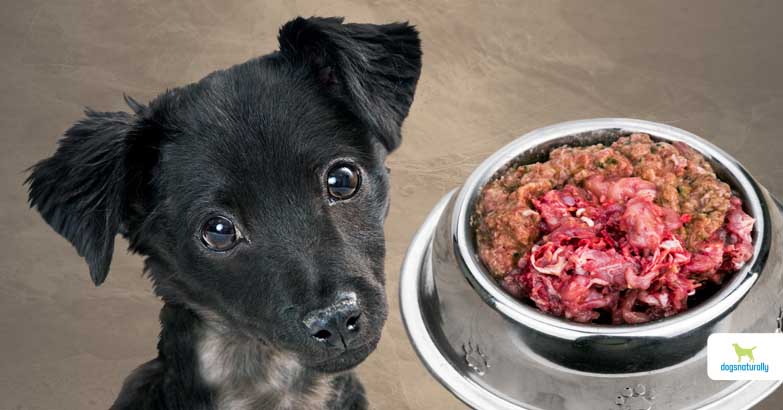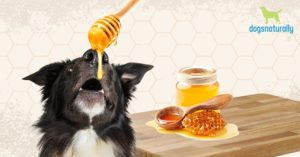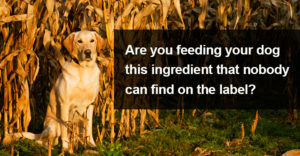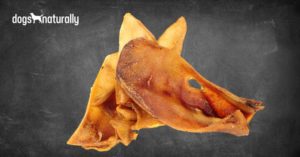I can’t remember exactly why I started feeding the raw diet for dogs, but I did all the same. There were certainly enough compelling reasons to stop feeding my dogs processed food.
After all, many dog food ingredients come from a chemistry lab, not nature.
But you probably don’t need the details of why I switched to raw dog food. I’m assuming if you’ve read this far, you’re ready to switch your dog to raw too.
But perhaps you’re a bit scared to make the switch to feeding your pets raw pet food…
You likely worry your dog will choke on bones or that his raw dog food won’t be balanced. And those are very valid concerns!
I’ll never forget lying on the floor, feeding my dog a fresh raw chicken wing and thinking “This is it … this is how I kill my dog.” I remember what it was like starting my dogs on raw. So I’m not going to tell you not to be scared.
Change is scary and I know you love your dog a lot. Otherwise, you’d just be tossing some cheap grocery store food in a bowl instead of reading this and searching for the best food.
So my job is to eliminate your fears so you can move your dog to a pure, safe, high quality raw dog food diet. And I’m up for the challenge because:
- I’m a raw feeding breeder and have raised dozens of puppies and seniors on a raw diet over the last 25 years.
- I’ve made a lot of mistakes and I can help you avoid them.
- I have a degree in physiology and co-wrote a Raw Food Certification Course with esteemed pet food nutritionist and veterinarian, Dr Marion Smart DVM PhD.
- Most importantly, I’m going to use that education and experience to show you, in 6 simple steps, how to make your own raw diet from scratch.
So if you’re thinking of switching to raw, then I applaud you! And I admire that you’re doing your research first and not just jumping in …
An unbalanced raw pet food diet done wrong can harm your dog.
But don’t worry about that … if you follow these rules, you won’t go wrong. I’m going to try to give you a scientific raw diet that’s easy to follow and understand.
Ready to start?
Step 1: Balance The Fat & Protein
Protein & Fat Rule
The staple of your dog’s meal is meat. You can buy meat from the grocery store or from the butcher. The fat content should be between 10% and 20%, including any oils you add to your dog’s meals.
All of your dog’s energy requirements come from just three sources: protein, fat and carbohydrate. These macronutrients are the only source of calories (energy) for your dog.
Protein is made of building blocks called amino acids. Amino acids are important not just for more energy, but to assemble tissues in your dog. They also make enzymes that fire important metabolic processes.
Fat is a rich source of energy. Pound for pound, fat contains double the amount of calories as protein. So you need to watch the amount of fat that goes into your dog. But make no mistake … fat is an important nutrient. It protects your dog’s cells and it’s used to make hormones and fat-soluble vitamins.
Both protein and fat are essential nutrients … that means your dog will literally die without a steady supply. But carbohydrates aren’t essential … your dog will do just fine without them.
This doesn’t mean some carbohydrates aren’t quality ingredients. Some forms of carbohydrate can boost your dog’s immune system and reduce his risk of cancer and other diseases. But not all carbohydrates carry this benefit … and we’ll circle back to that in a bit.
The foundation of your dog’s raw diet is proteins and fat. This makes up most of his meal. It’s as simple as buying ground meat or chunks and putting them in your dog’s bowl. But balance is important.
This means feeding a diet that’s about 10% to 20% fat total, including any fats like fish oil that you add to your dog’s raw diet. The remaining foundation of your dog’s raw meals will be protein.
It’s important to keep your fat within this range when feeding a raw diet for dogs. Here’s why …
Too Much Fat
Fat is relatively devoid of vitamins and minerals … and it contains a lot of calories. This presents a challenge if the raw diet is too high in fat.
If your dog’s diet contains more than 20% fat, it will cannibalize his vitamins and minerals. The resulting diet can be nutritionally incomplete. This is especially important for puppies and older dogs, who need more nutrients than adult dogs.
Too Little Fat
If the fat dips much below 10%, you’ll start to see dry, itchy skin in your dog. This is one of the first signs of fat deficiency. So try to stay within the 10% to 20% range most days.
Here’s a complete list of the typical fat percentage in common meats you can buy at the butcher or grocery store:
Fat Content Of Common Food
Ground beef (90% lean): 10%
Ground beef (80% lean): 20%
Regular ground beef: 30%
Beef liver: 4%
Ground chicken (skinless): 8%
Chicken necks (with skin): 25%
Chicken leg (with skin): 16%
Ground lamb: 21%
Ground turkey (skinless): 8%
Turkey neck (with skin): 6%
Duck (skinless): 6%
Ground pork: 21%
Rabbit: 2%
Deer: 9%
Salmon: 7%
Egg: 10%
So step 1 is finding the proteins for your dog and making sure the fat content is not too high or low. But before you choose the proteins your dog eats, it’s important to understand that your dog needs minerals.
Bone is an excellent source of many minerals, so that means you need to choose some meats that have the bone in. And if you don’t, you need to find a bone replacement. Let’s look at this step next …
Step 2: Get The Calcium And Minerals Right
Calcium Rule
10% to 15% of your dog’s total raw food diet needs to be bone. Puppies need at least 12% and up to 15% bone.
Your dog needs a steady supply of minerals and trace minerals. Along with enzymes from proteins, minerals are important cofactors that fire all of the metabolic processes in your dog’s body. If your dog is missing minerals, things can go very, very wrong. He can develop crippling joint disease, heart issues, seizures and more.
That might sound frightening, but it’s easy to get this step right with bones.
Bone is about 65% minerals, including phosphorus, magnesium and zinc … and most importantly, calcium. Calcium and phosphorus work synergistically in your dog’s body to move his muscles and control all of his body functions. So your dog needs a steady supply of these minerals.
Meat without any bone at all contains a lot of phosphorus and very little calcium.
If you fed your dog an all-meat diet without calcium, he would pull all of the calcium from his bones to get enough to move his muscles and control body processes. So if the diet is too low in calcium, you’ll often see bone and joint disease … especially in growing puppies.
So raw feeders add bone to meals to ensure there’s a steady supply of calcium and other important minerals.
If your dog were a wolf in the wild, he would eat whole animals like deer and rabbits. This type of wild prey averages about 12% bone with little variation. In fact, even eggs are 12% shell (another source of calcium).
So 10% to 15% of your dog’s total diet needs to be bone. Puppies need at least 12% and up to 15% bone to support their skeletal growth and development of adult teeth.
PRO TIP
It’s important that your dog’s bone is raw … cooking bones will cause them to dry out and this can create dangerous sharp edges.
Raw Dog Food Foundation: Minerals
To keep your dog’s bone content in the 12% to 15% range, you need some of his meats to have the bone in them. Start with the meaty bones you can find at your butcher or local pet store.
It’s important to make sure the bone matches the size of your dog. A 10 pound Chihuahua won’t be able to chew through a beef rib bone, but a 100 pound Rottweiler certainly can.
If your dog can’t eat all of the bone, then it’s not a good source of minerals. Make sure your dog can completely eat the bone.
You’ll also want to stay away from pieces your dog can swallow whole. If your butcher cuts up his ox tails into 2 inch pieces, your dog will swallow them whole and might not be able to digest them. And they might cause an intestinal blockage.
Try to choose bones that have a lot of joints, like necks, tails and feet … and bones that aren’t weight bearing. Weight bearing bones can break teeth or get stuck in the digestive tract. Meaty bones with a lot of small bones and joints are the safest choice for your dog.
PRO TIP
Dogs have a built-in mechanism for bone safety. If your dog swallows a piece of bone that’s too large to digest, he’ll often just throw it up for a second pass!
Typical Bone Content For Raw Dog Food
Here’s the bone content of common meaty bones you can find at your butcher or local pet store:
Chicken
- Whole chicken (not including the head and feet): 25%
- Leg quarter: 30%
- Split breast: 20%
- Thigh 15%
- Drumstick: 30%
- Wing: 45%
- Neck: 36%
- Back: 45%
- Feet: 60%
Turkey
- Whole turkey: 21%
- Thigh: 21%
- Drumstick: 20%
- Wing: 37%
- Neck: 42%
- Back: 41%
Duck
- Whole: 28%
- Neck: 50%
- Feet: 60%
Pork
- Feet: 30%
- Tails: 30%
- Ribs: 30%
Beef
- Ribs: 52%
- Oxtails: 45% to 65% (the bone percentage goes up as the tail gets thinner and less meaty)
Rabbit
- Whole rabbit (fur and all): 10%
- Whole rabbit (dressed): 28%
Lamb
- Rib: 27%
- Shoulder blade: 24%
- Whole shoulder (arm and blade): 21%
Obviously, if you fed your dog nothing but bone-in meats, he would get too much bone. So, in order to give your dog 10% to 15% bone, you need to mix the above bone choices with his meat.
You can do this with a little guesswork, or you can do the math.
Find The Percentage Of Bone
The simplest way to figure out how much bone is in your dog or cat’s diet is to know the percentage of bone in the foods you feed.
Let’s say you feed your dog a half pound of meat in the morning and a half pound of chicken necks in the evening. Using the above numbers, you know that chicken necks are 36% bone. So if they account for half of your dog’s food, then his diet would contain half that amount … or 18%. That’s a bit high, so if you fed your dog 2/3 pound meat and 1/3 chicken necks, now he would be eating 12% bone, which is perfect!
Here’s another example …
Let’s say you bought duck feet on sale at your local pet store. Using the above list, you know that duck feet are 60% bone. If you feed duck feet as half your dog’s meals, his bone content would be 30% … too high! But if you half that again, your dog would get 15% bone. Perfect! So you would feed 3/4 meat and 1/4 duck feet to get to 15% bone.
This is usually all you need to do … it’s fine to estimate the bone content since you don’t have to be exact with the amount of bone to feed. If you’re a bit off, your dog will be just fine. Just make sure you have at least 12% bone for puppies … they need a good supply of calcium to support their growth.
If you’re more of a math kind of person, here’s how to calculate the amount of bone in your dog’s raw diet:
How Much Bone In Raw Dog Food?
The amount of bone in your dog’s raw diet doesn’t have to be exact. But if you like hard numbers, then here’s some simple math to determine the percentage of bone in your dog’s raw diet:
Adult dogs: 12/ Percentage in food = % of diet
Puppies: 15/ Percentage in food = % of diet
Example math: If you go to the grocery store and find chicken necks, you know from the above table that they’re 42% bone. If you want to feed your dog 12% bone, then the calculation looks like:
12/42 x 100 = 29%
So 29% (or a bit less than 1/3 of your dog’s diet) should be chicken necks. So you can feed chicken necks every third meal to make it easy, or you can eyeball it and make chicken necks look like 1/3 of the diet. The math looks exact, but you don’t have to be all that exact with calcium. Just make sure you get 10% to 15%.
Calcium Replacements
If your dog is too small to consume bone or you have a dog who struggles to crunch through bone, you can give a bone substitute.
Many raw feeders use eggshell powder, but it’s missing magnesium, so it’s not a balanced choice for puppies or for any diet that contains more than 10% fat. Seaweed and coral calcium have a bit more calcium, but the same rule applies. The best bone replacement for raw diets is bone meal. Give 2 teaspoons bone meal powder per pound of food for adult dogs. For puppies and pregnant/nursing moms, view this calcium table and important information.
PRO TIP
If you’re using a calcium replacement, use bone meal. It’s the most natural replacement for bone since its actual, real bone. Feed 2 teaspoons per pound of food for adult dogs.
OK, if you’ve followed the first two steps, your dog’s basic protein and mineral requirements will be met. Next, you’ll want to make sure he gets enough vitamins.
Step 3: Add The Organ Meats
Organ Meat Rule
Liver should be 10% of the diet. Heart should be 5% of the diet. These organs are essential.
You should also try to get kidney, pancreas, spleen, lung, eyes, brain, sweetbread and green tripe. These can be an additional 5% to 10% of the diet, if your dog can tolerate it.
When raw feeding dogs, you need to remember that not all proteins are made the same. Some are richer in vitamins and minerals than others. Enter the organ meats … they’re Mother Nature’s multivitamins!
It’s difficult, if not impossible, to get enough vitamins and minerals in the raw diet without organ meats. And the organ that supplies the most, pound for pound, is the liver.
Add Liver
About 10% of your dog’s diet should be liver. This will supply most of his vitamins (such as vitamins B and C) and many of his minerals including copper and folate.
The main mistake raw feeders make is only adding liver. There are many other organs you should feed your dog … and your job is to source as many of them as you can.
Here are some organs you should try to get into your dog’s diet:
Add Heart
Heart is a major source of taurine so should be included in your dog’s raw diet. Not all dogs can make enough of this conditionally essential amino acid, so taurine must be in your dog’s raw diet. Taurine deficiency can cause heart disease.
Feed about 5% of your dog’s raw diet as heart.
Kidney, Pancreas, Spleen
Feeding your dog organs isn’t just for nutrition. Glandular therapy is based on the principle that organ meats support the corresponding organ in your dog.
For example, pancreas is rich in enzymes. If your dog has pancreas disease, he will have trouble making enzymes. So feeding pancreas will supply him with the enzymes he needs.
Another example is brain. Your dog needs DHA for healthy brains and nerves, especially puppies. And brain as an organ meat is rich in DHA, so it supports healthy brains and nervous systems.
Kidney, pancreas and spleen can be about 5% of your dog’s raw diet.
If you have trouble finding these organs at your butcher, you can buy them in powdered form. Make sure your powdered organs are freeze-dried so they aren’t harmed by heat processing.
Lung, Brain, Eyes, Sweetbread, Green Tripe
These are other organ meats you can try to find when raw feeding dogs. These other organs can also be about 5% of your dog’s diet. If you buy tripe, try to get green tripe from grass-fed animals. If the animal is fed corn, then pass on the tripe, as it will be too rich in unhealthy omega-6 fats.
Adding Organ Meats
Because organ meats are so rich in nutrients, they can cause digestive upset if you add too much, too soon. Start with about 5% of the diet as organs and gradually work up to 20% if your dog can tolerate it.
Step 4: Balance The Fats
Fat Balance Rule
Fats should be 10% to 20% of your dog’s diet. But not all fats are created equal!
There are two fat properties you need to consider with the raw diet for dogs:
- Saturation (this just refers to the number of double carbon bonds in a fat)
- Omega family (whether the fat is an omega-6 or omega-3 fat)
Saturated Fat
There are three main types of dietary fats: saturated, monounsaturated and polyunsaturated. The meats you feed your dog will have a combination of all three, but mainly saturated and polyunsaturated.
In the wild, grazing animals would normally eat grasses, while most birds would eat grasses, seeds and insects. But the farm animals we feed our dogs today typically eat a different diet that’s rich in grains. And that’s not good for your dog.
Grain-fed animals will contain more saturated fat than their grass-fed counterparts. Too much saturated fat can cause an imbalance of your dog’s gut flora or microbiome, so you need to limit the amount your dog gets.
Keep Saturated Fats Low
To limit the saturated fats in the raw dog food diet, follow these tips:
- Try to source grass-fed animals
- If that’s not possible or affordable, mix beef and poultry. Poultry is naturally higher in polyunsaturated fat and lower in saturated fat.
- Feed low fat meats and add polyunsaturated oils.
- Avoid coconut oil, which is saturated fat.
Omega Fats
There are two main types of polyunsaturated fats: omega-6 fats and omega-3 fats. Both fats help control the immune system and inflammatory response. Omega-6 fats tend to increase inflammation and omega-3 fats reduce it.
Just as grains change the amount of fatty acid in meats, they also change the omega fats. While wild animals eating grasses contain equal amounts of omega-6 and omega-3 fats, animals fed grains contain a lot more omega-6 fats. If this isn’t fixed, it can cause chronic inflammation in your dog, which is a major cause of chronic disease.
Here are some tips to balance the omega fats in raw diet for dogs and cats:
- Trim the skin off poultry. It can contain 30 times more omega-6 fat than omega-3.
- Avoid feeding pork if it’s not grass-fed. Pork has a lot of fat in the meat and can contain large amounts of omega-6 fat.
- Make sure you feed both poultry and ruminants (such as beef, lamb and goat).
- Add a source of omega-3 fats. My favorite sources are ahiflower or hemp (a good source of a healthy fat called GLA) and green lipped mussels (a sustainable and clean alternative to fish and marine oils that carries several beneficial omega-3 fats).
PRO TIP
Rotating your protein sources will not only help balance the fats and nutrients, but it can help prevent protein sensitivities and allergies.
Step 5: Raw Dog Food Needs Vegetation
Vegetation Rule
Add fruits and vegetables as 10% of the diet and choose organic if you can afford it. Broccoli, kale and especially broccolo sprouts are a good source of cancer-fighting and anti-inflammatory polyphenols. Blueberries have a special affinity for the brain and nervous system, and cranberries add bladder and kidney benefits … but most berries are a good choice.
Most people who are raw feeding dogs stop at step 4 … and that’s a mistake. Research shows that vegetables reduce the risk of cancer in both humans and dogs. This is because fruits and vegetables have important immune benefits.
All fruits and vegetables contain polyphenols, which are bioactive substances that play a role in health and immune function. Polyphenols can’t be digested by your dog. They pass through his small intestine to the colon, where they are fermented by bacteria that live there.
Polyphenols have powerful antioxidant and anti-inflammatory properties and have been extensively studied for their role in preventing and treating chronic diseases, including diabetes, cancer and neurodegenerative diseases.
Their immune benefits come mainly from short chain fatty acids … which are byproducts when bacteria consume polyphenols. So it’s important to have the right balance of fats in your dog’s microbiome, which makes it worthwhile to follow Step 4.
It’s important to note that these valuable polyphenols only come from plants and not from animal sources.
While fruits, berries and vegetables are an important addition to the raw diet, starchy carbohydrates like grains and legumes aren’t. They feed the wrong types of gut bacteria and are linked to chronic inflammation. You’ll also want to avoid high sugar fruits and use low sugar berries instead.
Step 6: Balance
Macronutrients Rule
Many raw diets are deficient in two key nutrients: Vitamin D and Manganese. To boost the vitamin D content, feed whole raw fish, egg yolks, vitamin D rich mushrooms or green lipped mussels. Green lipped mussels will also increase manganese levels, as will oysters and shellfish.
If you follow the first four steps, your dog’s raw meals will be reasonably balanced. But you’re giving your dog a raw diet because you want the ultimate in nutrition! This last step will make sure your dog gets enough of the two micronutrients that are most likely to be lacking in a raw diet.
Vitamin D
Your dog can’t make vitamin D from sunshine like you can … so he relies on his food to supply it. The problem is, many food animals are raised indoors and might be deficient in vitamin D. So there should be a source of vitamin D in the raw diet.
You’ll want to avoid vitamin D supplements because too much vitamin D can damage your dog’s kidneys. Here are some of my favorite food sources of vitamin D for the raw diet for dogs:
- Mushrooms: When mushrooms are exposed to sunshine, they can product vitamin D, just like animals.
- Egg yolks: Yolks from pastured hens raised in sunshine and eating a proper diet are rich in vitamin D. You can feed eggs several times a week.
- Mussels: Green lipped mussels and other mussel species are rich in vitamin D. They can also be fed as food supplements.
- Fatty fish: Salmon, sardines and mackerel are all rich in vitamin D, as is cod liver oil. This isn’t my favorite source of vitamin D however, because fish is not sustainable and contains heavy metals, dioxins and PCBs.
Manganese
Manganese is an essential trace mineral that activates important metabolic processes in the body. It also helps the body detoxify harmful free radicals.
Manganese deficiency is fairly common in raw fed dogs if you’re not careful.
If your dog is deficient in manganese, it will usually show as weakened ligaments and connective tissue that can cause joint issues such as cruciate tears.
Manganese can be found in spinach, but it’s richest in mussels, followed by oysters and shellfish.
How Much Raw Food To Feed
The amount of raw food you should feed your dog each day depends on life stages: whether he’s a puppy or an adult.
How Much Raw Food Should Adult Dogs Get?
As a starting point for raw foods, feed your dog about 2% to 3% of his ideal adult weight.
If your dog is very active, you may need to feed a little more. And if your dog is more of a couch potato, you may need to feed a little less.
The best way to tell if you’re feeding the right amount is to run your hands over your dog’s ribs. If you can feel the ribs, but not see them, your dog is at a good weight.
Feed adult dogs 2% to 3% of their ideal body weight daily. Unless your dog is very active, here is a rough guide to get started, based on your dog’s weight:
25 pound dog: 1/2 pound daily 50 pound dog: 1 pound daily 100 pound dog: 2 pounds daily
How Much Raw Food Should Puppies Get?
Pound for pound, puppies need more calories and nutrition than adult dogs. Puppies should eat 2% to 3% of their expected adult weight … or about 5% to 10% of their current weight.
Remember, puppies need to eat more calcium and less fat than adult dogs too. Try to feed puppies 15% bone and less than 20% fat to make sure they get enough nutrients and minerals.
Puppies need to eat more to support their growth. As a general meal plan guide, feed:
Puppies 2 to 3 months: 8% to 10% of body weight daily
Puppies 4 to 5 months: 6% to 8% of body weight daily
Puppies 6 to 8 months: 4% to 6% of body weight daily
Puppies 9 to 12 months: 3% to 4% of body weight daily
FAQ
Is raw food actually good for dogs?
Yes, feeding raw food can be beneficial for dogs, offering natural sources of proteins and fats that are essential for their health. Raw diets often include fresh meats and bs, which can provide a more biologically appropriate nutrient profile compared to processed dog foods.
Do vets recommend raw diet for dogs?
While some veterinarians support raw diets due to their potential health benefits, others may have concerns about the risks of bacterial contamination and nutritional imbalances. It’s important to consult a holistic vet knowledgeable in raw feeding to ensure the diet is safe and balanced for your specific dog.
References
Mussel Intake and Vitamin D Status in Humans (Mussel). U.S National Library of Medicine. 5, October 2016.
Raghavan M, Knapp D, Bonney P, Dawson MH, Glickman LT. Evaluation of the effect of dietary vegetable consumption on reducing risk of transitional cell carcinoma of the urinary bladder in Scottish Terriers. National Library Of Medicine. 1, July 2005.













